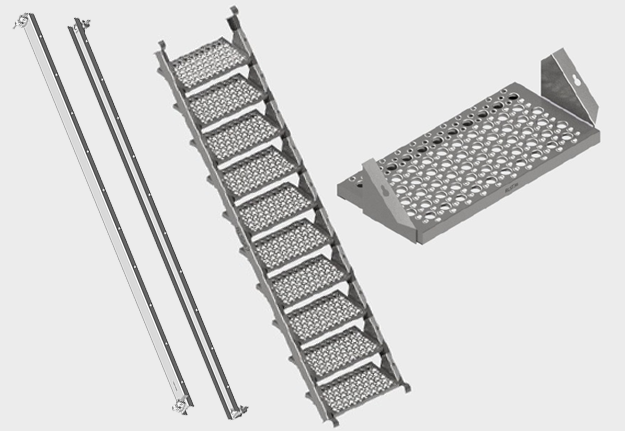Steel Stair Stringers
Make a proper base for the staircase in Scaffolds with AAIT’s Aluminum and Steel Stair Stringers and Stair Tread. Made of Aluminum alloy and steel, this can withstand heavy weights for a prolonged time. The galvanized layer keeps your Aluminum and Steel Stair Stringers looking good and strong. Need help picking the right Stair Stringers size? OR want more info on our stair stringers? Please visit our contact us page to get answers to your questions.
Steel Stair Stringers
AAIT provides you with the highest quality steel stair treads & stringers for superior strength and durability for your stairs. These high-grade steel stairs stringers are warping, cracking, and decay resistant and are versatile enough to install both indoors and outdoors. Its uniform design offers perfect fit with wide stair treads including wood, fiberglass, and steel. The baked powder coating finish of steel stair stringer is maintenance free and ensures maximum resistance to corrosion and heavy wear.
The AAIT’s steel stair stringers have unparalleled stability and security, providing a solid ground for any stair configuration. They come pre-assembled for fast and easy assembly with all required bolts included. Adjustable and modular, their versatility means you can support stairs from 2½ to 13 feet high. Choose AAIT’s stairs steel stringers for fail-safe, long-lasting stair solutions that are easy to build, secure, and will hold up to heavy use over time.
Benefits of AAIT’s Steel Stair Stringers
1. Simple yet Practical Design: AAIT’s steel stairs stringers are intended to be straightforward and uncomplicated to assemble, enabling you to choose and install the stair parts of preference – from 2x lumber to premium hardwood finishes (not included).
2. Flexible and Versatile: Steel stairs stringers can be conveniently modified and rearranged to suit permanent or temporary applications. New designs make possible the building of minimum 4 steps sections to reach intermediate landings.
3. Rustproof and Long Lasting: The powder coating protects the stairs steel stringers from rust as well as ensures durability for a long period, fitting in various premises including indoor and outdoor spaces.
These stairs steel stringers are versatile and ideal for basements, attics, lofts, garages, decks, warehouses, cabins, barns, and construction sites. The adaptable designs fit well in residential, commercial, and industrial use.
4. DIY Friendly: AAIT steel stair stringer is good for homeowners, remodelers, contractors, and builders looking for a quick, strong, and economical way to build stairs.
5. Easy Installation Setup: The steel stair stringer is pre-drilled and welded inside the step for easy installation along with speedy adjustment to any configuration even for multi-level arrangements.
Opt for AAIT’s stairs steel stringers for a reliable solution capable of offering flexibility according to different needs with efficiency and durability.












 Download
Download